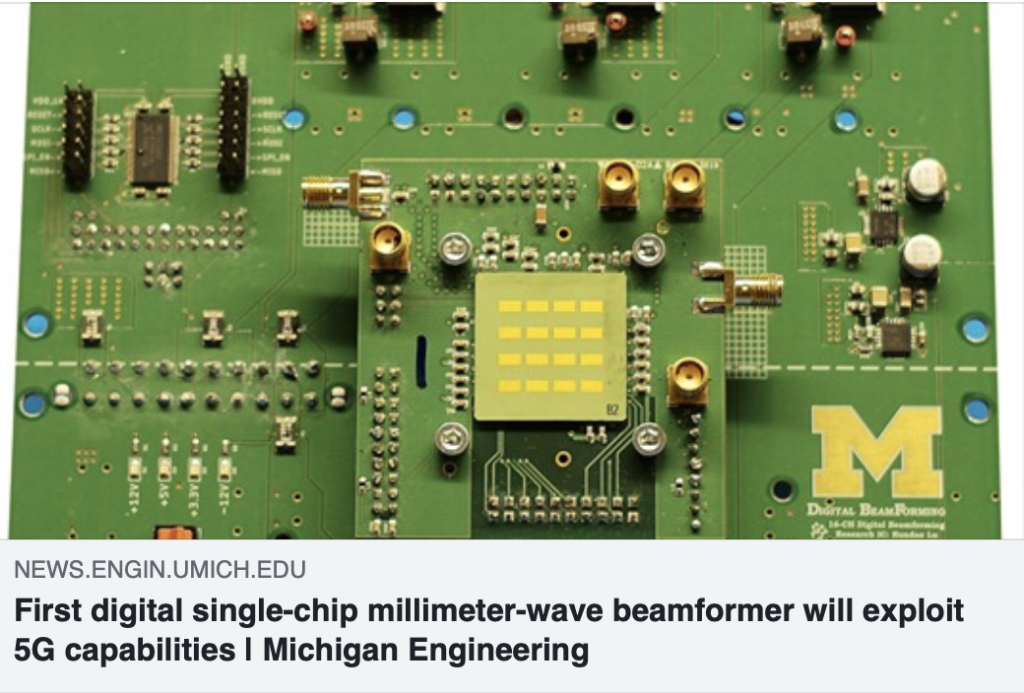5G used to be described as synonymous with millimeter-wave communications, but now when 5G networks are being rolled out all around the world, the focus is instead on Massive MIMO in the 3 GHz band. Moreover, millimeter-wave communications used to be synonymous with hybrid beamforming (e.g., using multiple analog phased arrays), often described as a necessary compromise between performance and hardware complexity. However, digital implementations are already on the way.
Last year, I wrote about experiments by NEC with a 24-antenna base station that carries out digital beamforming in the 28 GHz band. The same convergence towards digital solutions is happening for the chips that can be used in 5G terminals. The University of Michigan published experimental results at the 2020 IEEE Radio Frequency Integrated Circuits Symposium (RFIC) regarding a 16-element prototype for the 28 GHz band. The university calls it the “first digital single-chip millimeter-wave beamformer“. It is manufactured as a single chip using 40 nm CMOS technology and has a dimension of around 3 x 3 mm. The chip doesn’t include the 16 antenna elements (which are connected to it, see the image below and click on it to find larger images) but transceiver chains with low-noise amplifiers, phase-locked loops, analog-to-digital converters (ADCs), etc. While each antenna element has a separate ADC, groups of four adjacent ADCs are summing up their digital signals before they reach the baseband processor. Hence, from a MIMO perspective, this is essentially a digital four-antenna receiver.
One reason to call this a prototype rather than a full-fleshed solution is that the chip can only function as a receiver, but this doesn’t take away the fact that this is an important step forward. In an interview with the Michigan Engineering News Center, Professor Michael P. Flynn (who lead the research) is explaining that “With analog beamforming, you can only listen to one thing at a time” and “This chip represents more than seven years of work by multiple generations of graduate students”.
Needless to say, the first 5G base stations and cell phones that support millimeter-wave bands will make use of hybrid beamforming architectures. For example, the Ericsson Street Macro 6701 (that Verizon is utilizing in their network) contains multiple phased arrays, which can take 4 inputs and thereby produce up to 4 simultaneous beams. However, while the early adopters are making use of hybrid architectures, it becomes increasingly likely that fully digital architectures will be available when millimeter-wave technology becomes more widely adopted around the world.


Dear Professor,
Thanks for sharing this interesting work!
In their design, if I understood correctly, there are two summing operations: One is to sum outputs of four parallel ADCs for each antenna element to yield one 4GS/s bit-stream (c.f. Fig. 2); Another is to sum four 4GS/s bit-streams within an “4x Rx slice bank”, to form a “beam”(c.f. Fig.4). There are four Rx slice banks in total, leading to four “beams”.
Is this just a special case where the number of beams (i.e., 4) is not equal to the number of RF chains (i.e., 16)? I was told that they have to be equal.
The number of RF chains only sets an upper bound on how many beams that can be generated, i.e., how many directions that the array can listen in at the same time. One can always choose to utilize fewer beams than that; in Massive MIMO, it is typically preferred to have more RF chains than beams to guarantee that interference can be controlled between the beams.
In this case, I interpret the summation of the four parallel ADCs as being an unusual way of implementing “one antenna”. Normally, the signals would be added together before the ADC, but for some reason the signals are instead added after the ADCs.
Dear Professor,
Thanks again for your reply. You said “in Massive MIMO, it is typically preferred to have more RF chains than beams to guarantee that interference can be controlled between the beams”
Could you suggest me either a theoretical work to learn more about this principle, or any experimental work to see this is indeed the case in practice?
The books “Fundamentals of Massive MIMO” (by Marzetta et al.) and “Massive MIMO networks” (by myself, Sanguinetti, and Hoydis) are two theoretical works.
Dear professor, thank you for the article. May I note from you any free books/book titles on hybrid beamforming with illustrations of step by step mathematical modeling?
A popular paper on this topic is “An Overview of Signal Processing Techniques for Millimeter Wave MIMO Systems” https://arxiv.org/pdf/1512.03007.pdf
Dear professor,
I understand that if I want to transmit K beams, I need K RF chains. However, if I want to receive signals from M users simultaneously, do I need additional M RF chains to form M receive beams?
Yes, that is correct. I recommend that you watch the following video to get a deeper explanation: https://youtu.be/tXDN4BFSSnI?si=6wt3jWDBxfEkNn-K